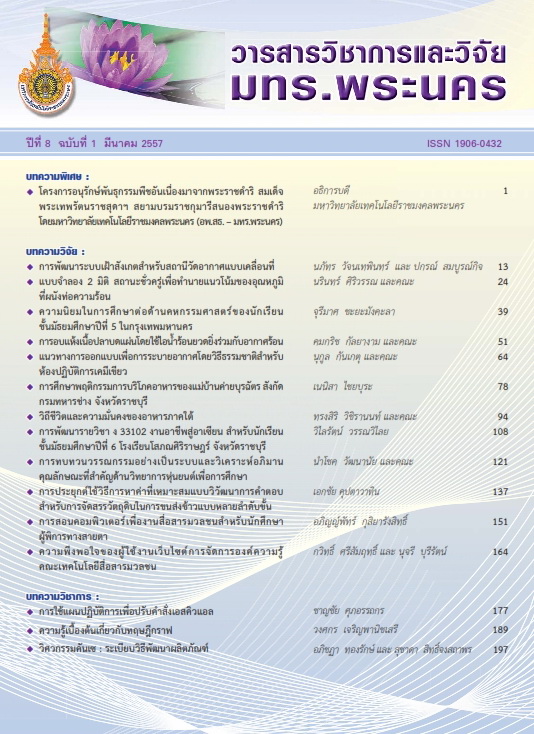การอบแห้งเนื้อปลาบดแผ่นโดยใช้ไอน้ำร้อนยวดยิ่งร่วมกับอากาศร้อน
Main Article Content
Abstract
บทคัดย่อ
งานวิจัยนี้มีวัตถุประสงค์เพื่อศึกษาการเปลี่ยนแปลงความชื้นของเนื้อปลาบดแผ่นในระหว่างการอบแห้งโดยใช้ไอน้ำร้อนยวดยิ่งร่วมกับอากาศร้อน และเปรียบเทียบสมบัติทางกายภาพของเนื้อปลาบดแผ่นที่ได้หลังการอบแห้งทางด้านสี ความแข็ง ความเหนียว การหดตัว รวมทั้งประเมินคุณภาพทางประสาทสัมผัส วิธีการอบแห้งเนื้อปลาบดแผ่นมี 2 วิธี วิธีที่ 1 เป็นการอบแห้งด้วยไอน้ำร้อนยวดยิ่งที่ 140 °ซ ตามด้วยอากาศร้อนที่ 110 °ซ (SSD+HAD) และวิธีที่ 2 เป็นการอบแห้งด้วยอากาศร้อนที่ 110 °ซ ตามด้วยไอน้ำร้อนยวดยิ่งที่ 220 °ซ และอากาศร้อนที่ 110 °ซ (HAD+SSD+HAD) โดยเนื้อปลาบดแผ่นที่ใช้สำหรับอบแห้งมีขนาด 50´50´1.3 และ50´50´2.2 (กว้าง´ยาว´หนา) มม. ทั้งนี้เนื้อปลาบดแผ่นมีความชื้นเริ่มต้นประมาณ 205-215 เปอร์เซ็นต์มาตรฐานแห้ง ถูกอบแห้งจนเหลือความชื้นสุดท้ายประมาณ 20 เปอร์เซ็นต์มาตรฐานแห้ง จากผลการทดลองพบว่า เนื้อปลาบดแผ่นหนา 1.3 มม. ใช้เวลาอบแห้งน้อยกว่าเนื้อปลาบดแผ่นหนา 2.2 มม. เนื้อปลาบดแผ่นที่อบแห้งด้วย SSD+HAD และHAD+SSD+HAD ใช้เวลาอบแห้งใกล้เคียงกัน ส่วนคุณภาพของเนื้อปลาบดแผ่นหลังการอบแห้งพบว่า ความสว่างมีค่าลดลง แต่ความแข็ง ความเหนียว และเปอร์เซ็นต์การหดตัวมีค่าเพิ่มขึ้นเมื่อความหนาของเนื้อปลาบดเพิ่มขึ้น เนื้อปลาบดแผ่นที่อบแห้งด้วย SSD+HAD มีความสว่าง ความแข็ง และความเหนียวมากกว่า แต่มีเปอร์เซ็นต์การหดตัวน้อยกว่าเนื้อปลาบดแผ่นที่อบแห้งด้วย HAD+SSD+HAD นอกจากนี้ยังพบว่า เนื้อปลาบดแผ่นที่อบแห้งด้วย HAD+SSD+HAD ได้รับคะแนนคุณลักษณะทางประสาทสัมผัสมากที่สุด
Abstract
The objectives of this research are, firstly, to study changes in moisture level of ground fish slices during drying with superheated steam combined with hot air, and secondly, to compare physical properties of dried fish slices, in terms of color, hardness, toughness and shrinkage, as well as sensory evaluation. Two drying methods were performed. The first was superheated steam drying at 140°C combined with hot air drying at 110°C (SSD+HAD). The second was hot air drying at 110°C combined with superheated steam drying at 220°C and hot air drying at 110°C (HAD+SSD+HAD). The ground fish samples had sizes of 50´50´1.3 and 50´50´2.2 (W´D´H) mm. The samples’ initial moisture content was around 205-215% dry basis. The samples were dried until the final moisture content reduced to about 20% dry basis. Results showed that the samples with 1.3mm thickness used shorter drying times than those with 2.2mm thickness. The samples dried by SSD+HAD and HAD+SSD+HAD methods used similar drying time. In terms of quality, it was found that the lightness of dried samples decreased, but the hardness, toughness, and shrinkage percentage of dried samples increased when the samples’ thickness increased. Dried samples obtained from SSD+HAD method had higher percentage of lightness, hardness and toughness, but lower percentage of shrinkage than those obtained from HAD+SSD+HAD method. Moreover, it was also found that dried samples obtained from HAD+SSD+HAD method had the highest sensory scores.


